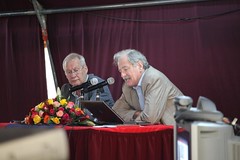The following are highlights of a presentation made by Carlos Seré to open the annual program meeting of the International Livestock Research Institute in Addis Ababa, Ethiopia, on 15 April 2010.
The reform process of the Consultative Group on International Agricultural Research (CGIAR) is moving full speed ahead. Yesterday, the board of trustees of the International Livestock Research Institute (ILRI) agreed that we join the new CGIAR Consortium.
How do we fold ILRI’s core competencies into the more integrative programs the new CGIAR is developing?
The food price crisis triggered a reconsideration of the importance of international agricultural research. We made a serious mistake in decreasing investments in this area over the last two decades, and it is clear that we are paying the price for that mistake now. There is now renewed interest in agriculture, with many different funds being set up to support it. At the recently concluded Global Consultation on Agricultural Research for Development, in Montpellier, France, there was public recognition that the research and development system has been operating in a fractured way.
Those of us doing international agricultural research have been doing our thing, the national agricultural research systems of developing countries have been doing their thing, and so on. And even if these research organizations had been working effectively together, they have not matched themselves to programs in complementary sectors—in roads and other kinds of infrastructure, in markets, in extension services. Our challenge now is to see how all these investments can be better aligned. Our effort in the CGIAR to establish a Consortium is one part of that overall requirement for much clearer and explicit alignment of the different parts of the development process.
Why should livestock be part of the new CGIAR?
We know that livestock research can explicitly address poverty. ILRI’s research paradigm makes use of a ‘systems perspective’. And, understanding that technical solutions are only part of what poor communities and countries need, ILRI researchers have developed an ‘innovations systems mindset’.
What does ILRI bring to the new CGIAR?
Some examples in the area of 7 global issues that ILRI research addresses.
- SUSTAINABLE INTENSIFICATION OF AGRICULTURAL SYSTEMS: more efficient and integrated mixed crop-and-livestock farming systems through development of improved dual-purpose food-feed crops and judicious use of available biomass.
- REDUCING PASTORAL VULNERABILITY: livestock vaccines, drought insurance for herders living in drylands, policies that encourage pastoral households to diversify their income sources.
- ADAPTATION AND MITIGATION STRATEGIES FOR CLIMATE CHANGE: livestock feeding regimens that increase milk yields while reducing the amounts of greenhouse gases produced; investigation of the levels of carbon sequestration in rangelands.
- ENHANCED FOOD SAFEY AND MARKET ACCESS: pro-poor regulations, policies and incentives, particularly for smallholder dairy systems in East Africa and South Asia.
- PREVENTION OR CONTROL OF EMERGING ZOONOTIC DISEASES: risk maps, better control of livestock disease outbreaks through participatory epidemiology.
- DEVELOPMENT OF LIVESTOCK VACCINES: improved existing vaccines and development of new ones and innovative public-private vehicles for delivering them to poor livestock keepers.
- 7 CONSERVATION AND USE OF ANIMAL GENETIC RESOURCES: evidence to support conservation priority setting, development of reproductive technologies and other methodologies for better conservation and use of native stock in poor countries.
What are our challenges? How do we integrate all this intelligently into the new CGIAR Consortium and its Mega Programs? How do we implement gender issues into all our research work? How do we build greater capacity in our national and regional partners in developing countries? How do we build the trust needed to make the new and deeper partnerships required by the new way of operating in the new CGIAR? And how do we do a better job of quickly distilling the knowledge from our research to address urgent global issues such as climate change and emerging diseases?

